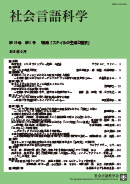Volume 3, Issue 2
Displaying 1-15 of 15 articles from this issue
- |<
- <
- 1
- >
- >|
-
Article type: Article
2001 Volume 3 Issue 2 Pages 1-3
Published: March 30, 2001
Released on J-STAGE: April 27, 2017
Download PDF (311K) -
Article type: Article
2001 Volume 3 Issue 2 Pages 4-16
Published: March 30, 2001
Released on J-STAGE: April 27, 2017
Download PDF (1290K) -
Article type: Article
2001 Volume 3 Issue 2 Pages 17-26
Published: March 30, 2001
Released on J-STAGE: April 27, 2017
Download PDF (941K) -
Article type: Article
2001 Volume 3 Issue 2 Pages 27-38
Published: March 30, 2001
Released on J-STAGE: April 27, 2017
Download PDF (946K) -
Article type: Article
2001 Volume 3 Issue 2 Pages 39-51
Published: March 30, 2001
Released on J-STAGE: April 27, 2017
Download PDF (1206K) -
Article type: Article
2001 Volume 3 Issue 2 Pages 52-62
Published: March 30, 2001
Released on J-STAGE: April 27, 2017
Download PDF (1134K) -
Article type: Article
2001 Volume 3 Issue 2 Pages 63-76
Published: March 30, 2001
Released on J-STAGE: April 27, 2017
Download PDF (1711K) -
Article type: Article
2001 Volume 3 Issue 2 Pages 77-83
Published: March 30, 2001
Released on J-STAGE: April 27, 2017
Download PDF (676K) -
Article type: Article
2001 Volume 3 Issue 2 Pages 84-86
Published: March 30, 2001
Released on J-STAGE: April 27, 2017
Download PDF (295K) -
Article type: Article
2001 Volume 3 Issue 2 Pages 87-89
Published: March 30, 2001
Released on J-STAGE: April 27, 2017
Download PDF (397K) -
Article type: Article
2001 Volume 3 Issue 2 Pages 90-95
Published: March 30, 2001
Released on J-STAGE: April 27, 2017
Download PDF (698K) -
Article type: Article
2001 Volume 3 Issue 2 Pages 96-98
Published: March 30, 2001
Released on J-STAGE: April 27, 2017
Download PDF (380K) -
Article type: Article
2001 Volume 3 Issue 2 Pages 99-101
Published: March 30, 2001
Released on J-STAGE: April 27, 2017
Download PDF (399K) -
Article type: Article
2001 Volume 3 Issue 2 Pages 102-104
Published: March 30, 2001
Released on J-STAGE: April 27, 2017
Download PDF (310K) -
Article type: Appendix
2001 Volume 3 Issue 2 Pages 105-
Published: March 30, 2001
Released on J-STAGE: April 27, 2017
Download PDF (69K)
- |<
- <
- 1
- >
- >|
